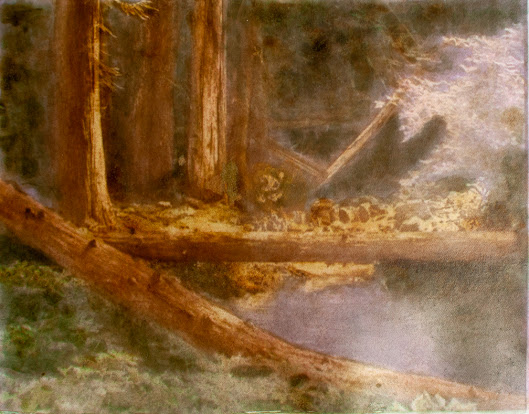This print was even more complex image to print than "Proxy Falls", and that print was quite complex. Complex, in the numerous color variations of the elements, as well as the different tonal levels to consider, and all of those variations had to be mentally mapped out, layer by layer, with the various print times for each different tonal level that was being worked on. The print time controlling only the level affected, as well as the tonal levels below. The tonality being printed to being the level most affected by the float time, which is further controlled by the water temperature of the float water. The lower the temperature of the water the less affect of gum reduction. At 68 degrees, about the only gum reduction would be at the highest level printed to. If that be zone 7 [whites with full texture], then 1-3 minutes of floating would reduce only the gum at that level, all the lower tonal areas would be hardened by the cool water.
The print being seen is not the first attempt at printing. The first print I made was darker and simply overworked. That is because I hadn't gotten the print times down close enough for the control necessary to leave the gum where it was needed, without needing a second coating, hence darkening the image. Gum printing is the most complex photo process there is. There are no 'standard' ways of printing, endless possibilities and no boundaries. After forty years the process has become almost second nature, evaluating each addition of gum to a print after careful evaluation and thought. Half being the methodological part; how much color in the gum mixture, where applied, how much print time to keep the gum there, with just enough reduction to allow the excess color to come off, leaving just what was desired. And all that, to arrive at the ideal finished print in you head, to translate onto the paper with good fidelity. Previsualization being the term I learned when I began as a photographer.
This print was achieved in ten print layers, using colors. The basic image was created with a standard CYMK printing, although I reversed that order for this print, using KMYC, laying the black first and only printed to zine 3; print time 3 minutes. The magenta was laid on next and printed for eight minutes, which was to about zone 6, below the sky being printed in Most of the sky area are clouds, so they amount to zone 7 (ish) white with texture, here, being the soft turquoise blue of the sky. The focal elements in the print are in the center area, on the left/center is where the late afternoon sunlight is on the far shore of the river and rocks crossing. On the right are several trees in direct sunlight, standing out as being bright. Those I kept the printing times below their tonal range, which would have been zone 7-8. They got the last of the printings, with very shear colors, to keep the brilliance of the light. For me, it's all about the lighting.
Thus, this print has taken two months to see a final print. That's just how fine gum printing demands. Patience is truly the underlying virtue to gum printing. For those who are in a hurry or impatient, they'd hate it.
Gum Dichromate Print 11"x14"
"Willamette River Upstream"



